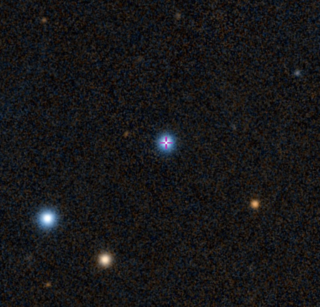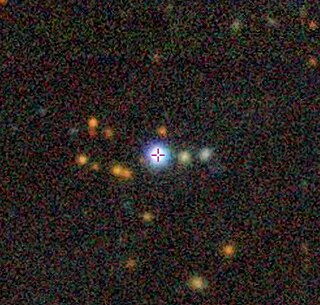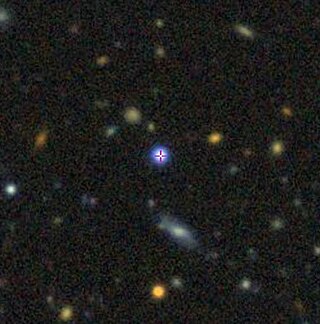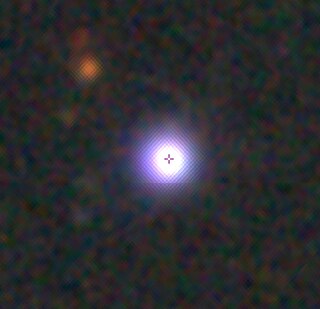
A blazar is an active galactic nucleus (AGN) with a relativistic jet directed very nearly towards an observer. Relativistic beaming of electromagnetic radiation from the jet makes blazars appear much brighter than they would be if the jet were pointed in a direction away from Earth. Blazars are powerful sources of emission across the electromagnetic spectrum and are observed to be sources of high-energy gamma ray photons. Blazars are highly variable sources, often undergoing rapid and dramatic fluctuations in brightness on short timescales. Some blazar jets appear to exhibit superluminal motion, another consequence of material in the jet traveling toward the observer at nearly the speed of light.

PKS 0637-752 is a quasar located six billion light years in the constellation of Mensa. It is noted for having a bright and largest astrophysical jet at redshift of z = 0.651. Discovered by Einstein Observatory in 1980 through X-rays, PKS 0637-752 was the first celestial object to be observed by Chandra X-ray Observatory upon its commissioning in July 23, 1999.

4C +71.07 known as S5 0836+71, is a quasar located in the constellation Ursa Major. Based on its high redshift, the object is located 10.7 billion light-years away from Earth and such, classified as a blazar with a flat-spectrum radio source and features a radio jet.

PKS 0438-436, also known as PKS J0440-4333, is a quasar located in constellation Caelum. With a high redshift of 2.86, the object is located 11.2 billion light-years from Earth and is classified as a blazar due to its flat-spectrum radio source, (in terms of the flux density as with α < 0.5 and its optical polarization.

PKS 2126-158, also known as PKS 2126-15, is a quasar located in Capricornus. It has a redshift of 3.268000, which corresponds to the distance of 11.5 billion light years. It is classified as a gigahertz peaked-spectrum quasar (GPS) with a flat-spectrum radio source and a blazar, a type of active galaxy shooting an astrophysical jet towards Earth.

PKS 0226-559 known as PMN J0228-5546 is a quasar located in the constellation Horologium. At the redshift of 2.464, the object is roughly 10.6 billion light-years from Earth.

PKS 0451-28, also known as MRC 0451-282, is a quasar located in the constellation of Caelum. Its redshift is 2.55, estimating the object to be located nearly 10.8 billion light-years away from Earth.

PKS 1144-379 also known as PKS B1144-379, is a quasar located in the constellation of Centaurus. At the redshift of 1.048, the object is located nearly 8 billion light-years from Earth.

PKS 1402+044 is a quasar located in the constellation of Virgo. It has a redshift of 3.207, estimating the object to be located 11.3 billion light-years away from Earth.

PKS 0805-07 also known as PMN J0808-0751 and 4FGL J0808.2-0751, is a quasar located in the constellation of Monoceros. With a redshift of 1.83, light has taken at least 10 billion light-years to reach Earth.

NRAO 530 or PKS 1730-13 is a flat-spectrum radio quasar located in the southern constellation of Serpens. It has a redshift of 0.902. and was first discovered by two astronomers, W.J. Welch and Hyron Spinrad in 1973. It is classified as a blazar because of its optical variability across the electromagnetic spectrum in radio, gamma ray and X-ray bands. This quasar is also further categorized an OVV quasar.

PKS 0208-512 is a blazar located in the southern constellation of Eridanus. It has a redshift of 1.003 and was first discovered in 1975 by astronomers conducting the Parkes 2700 MHz survey in Australia as a bright astronomical radio source. This object is also classified highly polarized with the radio spectrum appearing to be flat, thus making it a flat-spectrum radio quasar.

PKS 1424-418 is a blazar located in the constellation of Centaurus. It has a redshift of 1.522 and was first discovered in 1971 by astronomer Keith Peter Tritton who identified the object as ultraviolet-excessive. This object is also highly polarized with a compact radio source. The radio spectrum of this source appears flat, making it a flat-spectrum radio quasar.

PKS 0537-441 is a blazar located in the constellation of Pictor. It has a redshift of 0.896 and was discovered in 1973 by an American astronomer named Olin J. Eggen, who noted it as a luminous quasar. This is a BL Lacertae object in literature because of its featureless optical spectra as well as both a possible gravitational microlensing and a gravitationally lensed candidate. Its radio source is found compact and is characterized by a spectral peak in the gigahertz range, making it a gigahertz-peaked spectrum source (GPS).

PKS 0420-014 is a blazar located in the constellation of Eridanus. This is a high polarized quasar with a redshift of (z) 0.915, first discovered as an astronomical radio source by astronomers in 1975. The radio spectrum of this source appears to be flat, making it a flat-spectrum radio quasar (FRSQ).

PKS 0458-020 also known as PKS 0458-02, is a quasar located in the constellation of Orion. It has a redshift of (z) 2.286 and was first identified as an astronomical radio source during the radio survey conducted by Parkes Observatory in 1966. Subsequently the source was shown to display optical behavior before being classfied as a blazar via an optical polarimetry study in 1985. This source also shows radio spectrum appearing to be flat, hence making it a flat-spectrum radio quasar (FRSQ).

PKS 1510-089 is a blazar located in the constellation of Libra, categorized as a highly polarized quasar showing fast variations in polarization angles, with a redshift of (z) 0.361. It was first discovered in 1966 as an astronomical radio source during the Parkes Observatory survey in 1966. The radio spectrum of the source appears flat, thus making it a flat-spectrum radio quasar (FRSQ).

PKS 2255-282 is a blazar located in the constellation of Piscis Austrinus. This is a low-polarized quasar at the redshift of 0.926, first discovered in 1975 by astronomers via a spectroscopic observation. The radio spectrum of this source appears as flat, making it as a flat-spectrum quasar but also a Gigahertz Peaked Spectrum source (GPS) with turnover frequency between 22 and 37 GHz.

PKS 1127-145 is a radio-loud quasar located in the constellation of Crater. This is a Gigahertz Peaked Spectrum object with a redshift of (z) 1.187, first discovered by astronomers in 1966. Its radio spectrum appears to be flat making it a flat-spectrum radio quasar, or an FRSQ in short.

PKS 0528+134 is a distant blazar located in the Galactic anticenter towards the constellation of Orion. This is a compact radio quasar, classified as radio-loud with a redshift of (z) 2.07 yet having low polarization. It was first discovered in 1977 by astronomers as a radio source and contains a radio spectrum that appears as flat making it a flat-spectrum radio quasar. It has an optical brightness of 19.5.




















